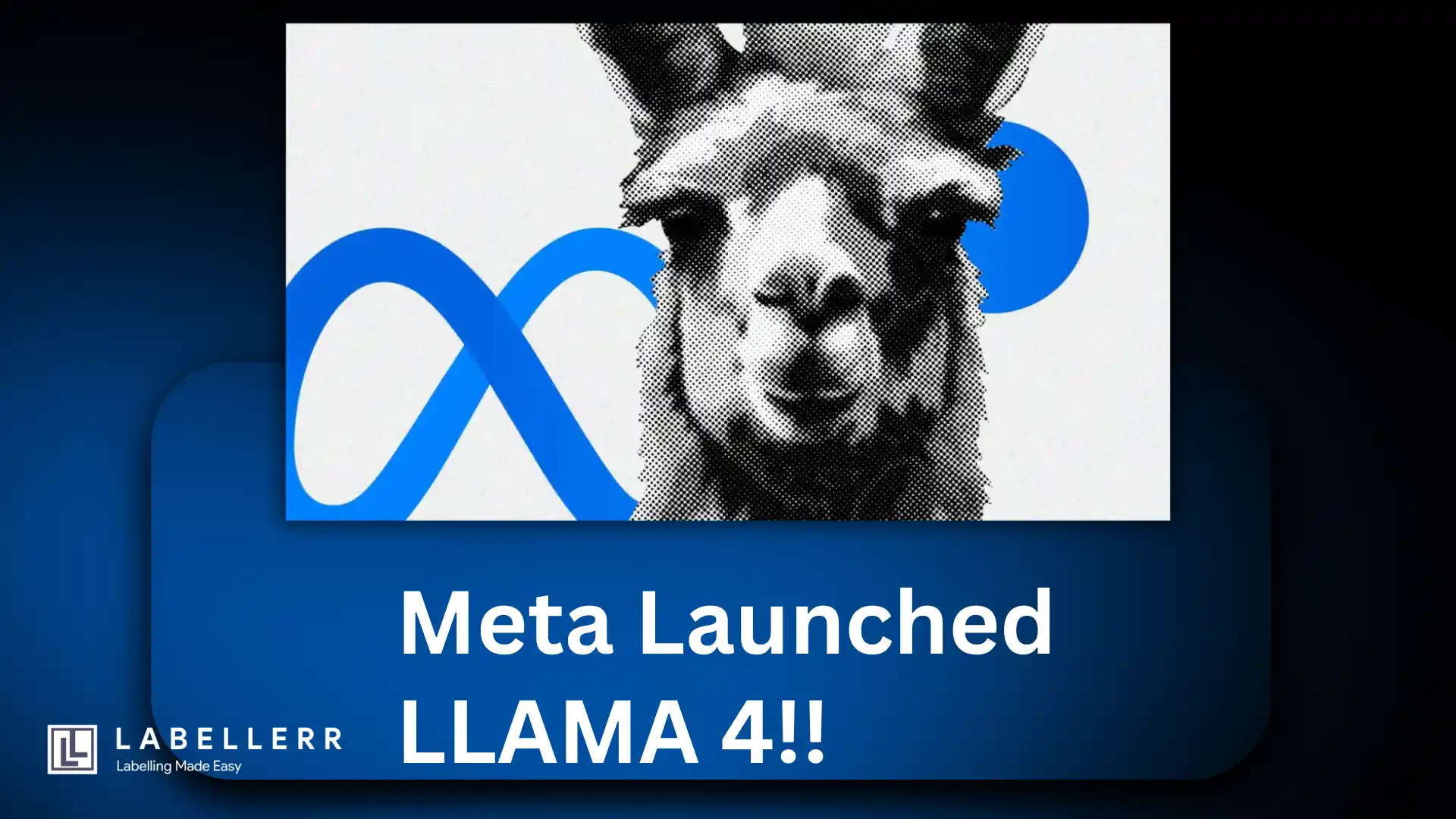Llama 4 Unleashed: What’s New in This LLM?
Llama 4 is Meta’s latest large language model (LLM), bringing better reasoning, longer context, and smarter responses. Explore how it compares to other LLMs and what it means for developers, researchers, and businesses using AI.

Launching an AI model on a Saturday might seem unusual, but Meta did just that with Llama 4. In a tech world where new AI models appear almost weekly, it's hard to tell which ones truly matter.
Meta's latest release, Llama 4, claims to stand out with several notable features:
- It is a natively multimodal model, meaning it was pre-trained to integrate text, images, and video tokens into a unified architecture using an early fusion design, but does not support direct user-uploads or real-time image processing.
- It has a massive 10-million-token memory (context window), letting it process huge amounts of information at once.
- It uses a smart design called Mixture-of-Experts (MoE) to be more efficient.

Whether you are an AI developer, researcher, business leader, or a tech enthusiast, you'll learn about Llama 4's capabilities, compare it with existing models, examine its practical applications, and discuss potential challenges, helping you determine its relevance in the evolving AI landscape.
What Exactly Is Llama 4?

Llama 4 has arrived. It isn't just a small improvement; it aims to be a major leap forward by introducing completely new ideas for the Llama family:
Different Sizes: Again, it comes in different versions: the efficient Scout (109B total parameters, but only 17B active at once), the powerful Maverick (400B total / 17B active), and the giant Behemoth (1.9T total / 288B active), which focuses on science and math and is still being developed.
Built-in Multimodality: Unlike previous versions, Llama 4 understands text, images, and video together right from the start. It uses a special design (early fusion) to process all these data types seamlessly.
Mixture-of-Experts (MoE) Design: This is a smarter way to build huge models. Instead of the entire massive model working on every task, MoE activates only small, specialized parts ("experts") when needed.
This makes Llama 4 (especially the larger Maverick and Behemoth versions) much faster and cheaper to run than a traditional model of the same huge size (like its 400B or 1.9T parameter total counts).
Massive Context Window: The Llama 4 Scout model boasts an incredible 10-million-token memory.
This lets it analyze extremely long documents, entire codebases, or even hours of video – far more than most other models. Maverick has a 1-million-token window.
Even More Data & Efficiency: Llama 4 learned from 30 trillion tokens (double Llama 3's data!), including lots of images and video.
Meta also used new training tricks (like FP8 precision) to train these huge models very efficiently.
Benchmarks

What Meta Claims About Llama 4 Scout?
Meta positions Llama 4 Scout as an efficient model.
The results show it competes well against models like Gemini 2.0 Flash-Lite, Gemma 3 27B, and Mistral 3.1 24B. According to Meta's chart, Scout performs strongly in:
Image Reasoning (MMMU score: 69.4)
- Image Understanding (Chart QA score: 88.8, DocVQA score: 94.4)
- Reasoning & Knowledge (MMLU Pro score: 74.3)
What Meta Claims About Llama 4 Maverick?
Meta presents Llama 4 Maverick as offering top performance very efficiently. The company compares it to models like Gemini 2.0 Flash, DeepSeek v3.1, and GPT-4o. Meta highlights Maverick's leading scores in:
- Image Reasoning and Understanding (MMMU score: 73.4, Chart QA score: 90.0)
- Coding (LiveCodeBench score: 43.4)
- Reasoning & Knowledge (MMLU Pro score: 80.5)
Handling Long Information (MTOB Full Book score: 50.8)
Meta also claims Maverick is very cost-effective. They estimate its cost at $0.19-$0.49 per million tokens (a measure of usage), much lower than the listed cost for GPT-4o ($4.38).
What Meta Claims About Llama 4 Behemoth:
Meta describes Llama 4 Behemoth as its largest and most powerful model. The company claims it matches or beats top models like Gemini 2.0 Pro, GPT-4.5, and Claude Sonnet 3.7. Based on the chart, Meta says Behemoth excels in many areas, including:
- Reasoning & Knowledge (MATH-500 score: 95.0, MMLU Pro score: 82.2)
- Coding (LiveCodeBench score: 49.4)
- Understanding Multiple Languages (Multilingual MMLU score: 85.8)
- Image Reasoning (MMMU score: 76.1)
The Flip Side: Criticisms, Challenges, and What People Missed
Llama 4's launch wasn't all smooth sailing. It faced some significant criticism alongside the praise.
Why Were Some People Disappointed?
- Performance Questions: Some felt Meta might have "gamed" certain benchmark scores by using special versions not available to the public.
Users also reported that Maverick, while good, didn't always beat competitors like DeepSeek or Claude in real-world coding or complex reasoning tasks.
Some found it made basic mistakes. - Big and Hungry: These are large models. Running Scout needs a powerful (and expensive) GPU, and Maverick needs even more.
Critics argued smaller models from competitors might offer similar results for less computing power. - "Open" But Not Fully: The license restrictions (blocking huge companies) and a sometimes clunky download process annoyed some users who wanted truly unrestricted open source.
- Development Concerns: Reports surfaced suggesting a rushed development cycle to meet deadlines.
The departure of some key researchers before the launch also raised eyebrows about internal confidence or strategy. - Patchy Support: At launch, some users found the documentation and community support less helpful than expected, facing bugs and implementation hurdles.
But Wait... What Might Critics Be Missing?
While the criticisms are valid points to consider, they might overshadow some truly important advancements:
- Real Architectural Innovation: The Mixture-of-Experts (MoE) design is a big deal for making huge models efficient.
And building multimodality in from the very start (early fusion) is technically difficult and could lead to deeper understanding than simply adding image capabilities later.
These are major engineering achievements. - That Giant Context Window: Scout's 10-million-token window is genuinely industry-leading right now.
This unlocks applications (like analyzing massive codebases or hours of video) that are simply impossible for most other models. - The Power of Open Weights (Even with Limits): Despite the restrictions, making the model weights available is still huge.
It allows most developers, researchers, and businesses to fine-tune, inspect, and deploy the models locally, offering control and potential cost savings unavailable with closed APIs. - Strong Multilingual Skills: Llama 4 performs very well in many languages, including some less common ones, making it valuable for global applications.
So, should you care?
- Yes, definitely if: You need deep customization, want to run models locally for privacy/cost reasons, need its massive context window, or want to research its unique architecture.
The open-weight nature is a key advantage here, despite limitations. - Maybe, if: You rely on APIs but watch the market. Llama 4’s strengths (and weaknesses) push competitors.
You might also find specific tools built on Llama 4 that outperform others for certain tasks. - Carefully consider if: You need the absolute best, most reliable performance today on tasks like coding or complex reasoning, or if you lack the technical resources/expertise to manage large, open-weight models.
The criticisms suggest it might not always match the very top closed models in reliability yet.
Conclusion
Llama 4 isn't perfect, but it's undeniably important. It pushes boundaries in model architecture and accessibility.
Its impact comes not just from its own power, but from how it shapes the choices and progress of the entire AI field.
Weighing its groundbreaking potential against its current criticisms is key to deciding if you should care right now.
FAQs
What is Llama 4?
Llama 4 is the fourth-generation large language model developed by Meta. It builds on Llama 3 with improved reasoning, speed, and context length.
How is Llama 4 better than Llama 3?
Llama 4 offers more accurate answers, supports longer conversations, and understands context better than Llama 3.
What can you use Llama 4 for?
You can use Llama 4 for chatbots, content creation, research, coding help, and many other natural language tasks.

Simplify Your Data Annotation Workflow With Proven Strategies
.png)


